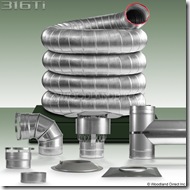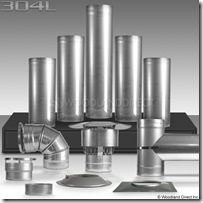There are many different reasons for lining or relining your chimney. Two of the most common reasons would be to repair a damaged or compromised chi
 mney, or to connect a new heating appliance to an existing chimney. The causes for a damaged chimney could be from a chimney fire, your home settling, lightning, and even hurricanes.
mney, or to connect a new heating appliance to an existing chimney. The causes for a damaged chimney could be from a chimney fire, your home settling, lightning, and even hurricanes.Chimney relining is one of the most practical and affordable ways for you to repair a damaged or deteriorated chimney. Older chimneys may be unlined or their original clay tile liners may have deteriorated over time. Deteriorated or missing liners may allow smoke, creosote, or even condensation to seep through your chimney walls causing more extensive damage. In case of a chimney fire, cracked or missing liners provide easier access for the fire to spread to nearby combustibles.
Another reason you may want to reline is to prevent any creosote buildup in your chimney. Creosote buildup is more likely to occur when venting a woodstove or wood insert into an existing masonry chimney. Excessive creosote buildup puts your chimney at a higher risk for fire. Connecting a chimney liner from the heating appliance through the chimney provid
 es a safe continuous passage way for the hot flue exhaust and helps protect the existing masonry chimney. If you are using a wood burning or multi-fuel stove, lining your chimney will create a continuous smooth area with fewer surfaces for soot and tar to stick too. Any tar that does form on the walls of the liner can flow directly back to the stove and be re-combusted instead of building up in the crevices of a masonry chimney.
es a safe continuous passage way for the hot flue exhaust and helps protect the existing masonry chimney. If you are using a wood burning or multi-fuel stove, lining your chimney will create a continuous smooth area with fewer surfaces for soot and tar to stick too. Any tar that does form on the walls of the liner can flow directly back to the stove and be re-combusted instead of building up in the crevices of a masonry chimney.When relining your chimney it is important that you properly insulate the chimney liner. By insulating the liner, you will help keep the temperature of the flue gases hot, improving the draw of the chimney since warm air rises. Also, in most cases a liner will need to be insulated to retain its rating as a UL listed liner system. Insulation is provided with most relining systems.
A new chimney liner is an effective way to keep carbon monoxide, moisture, smoke, creosote, and other products of combustion from seeping through the bricks and mortar of your existing chimney and leaking into your home. As you can see, a secure lining system is an important part of a safe and functional chimney system.
No comments:
Post a Comment